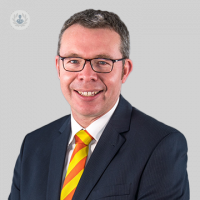Robotic-assisted radical prostatectomy: what you need to know
Escrito por:Robotic-assisted radical prostatectomy is a minimally invasive surgery to remove the prostate gland and some surrounding tissue, using robotic technology. The surgeon controls robotic arms equipped with surgical instruments, providing precision, smaller incisions, reduced blood loss, and quicker recovery compared to traditional open surgery. Distinguished consultant urologist Mr Aidan Noon provides an insight into the treatment, including an explanation of the approach he uses in his practice.

What factors should patients consider when opting for robotic-assisted radical prostatectomy?
The first thing patients need to consider is which treatment option is most suitable for them and how it will impact their lives. Men diagnosed with prostate cancer often face a variety of treatment choices, and navigating these options can be stressful, especially without specialized knowledge.
As a specialist in prostate cancer, I need to understand the type, stage, and grade of the cancer. Some types of cancer are best treated with surgical removal, such as through a robotic prostatectomy. However, the suitability for surgery also depends on specific patient factors.
Even with advanced robotic techniques, patients must be fit for pelvic surgery. Factors that can complicate this operation include a high body mass index (obesity), which affects positioning and ventilation, as well as serious heart and lung conditions or blood clotting disorders. Extensive prior abdominal surgery can also be a concern, necessitating alternative treatment options. A specialist surgeon can assess these issues and provide guidance.
It is crucial for patients to envision their life after treatment. In the urgency to address cancer, the post-treatment quality of life can be overlooked. Robotic prostatectomy can affect urinary continence and erectile function, so understanding these potential impacts is essential. Fortunately, modern techniques and anticipatory measures offer significant support for managing these side effects. Patients should also consider their personal circumstances and work demands when evaluating treatment options.
One of the advantages of a prostatectomy is the possibility of it being an outpatient procedure, allowing patients to leave the hospital the same day if the operation is successful. This minimally invasive approach facilitates a quicker return to work, which is particularly beneficial for younger patients and those with professional obligations.
Finally, selecting an experienced surgeon and a competent surgical team is vital. Patients should seek treatment at a high-volume centre with a surgeon who has substantial experience and a strong track record in both the surgery and post-operative care.
What are the key steps involved in robotic-assisted radical prostatectomy surgery?
The first thing we do is ensure safe entry into the abdomen, typically by making an incision just above the umbilicus, or belly button. We use a safe technique to inspect the area and position our robotic instruments accurately. Occasionally, if patients have had previous operations like hernias or appendectomies, we may encounter internal scarring that needs attention.
Next, we mobilise the bladder and access the prostate. I use a posterior approach, dissecting out the seminal vesicles and the vas, and then proceed under the prostate. Pre-surgery MRI scans inform us of the prostate cancer's location, so we can carefully dissect around the affected area.
The two most important parts of the operation involve reconstruction: securely joining the bladder to the urethra (the water pipe). This step requires ensuring sufficient urethral length and a watertight anastomosis, which is the term for the join.
During the prostate dissection, we aim to employ a nerve-sparing approach when possible. We are aware of the nerves essential for erectile function and strive to preserve them, though this isn't always feasible, particularly with advanced cancer. Attempting to spare tissue can risk leaving cancer behind. In cases of inflamed prostates, the priority is to remove all cancerous tissue. Nonetheless, we generally make efforts to preserve some nerve fibres.
After removing the prostate gland and completing the reconstruction, we ensure the abdominal wall defects are closed with sutures that dissolve over time.
If you require robotic-assisted radical prostatectomy surgery and would like to book a consultation with Mr Noon, do not hesitate to do so by visiting his Top Doctors profile today


